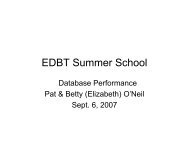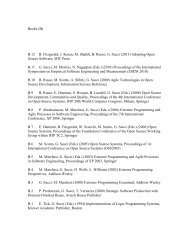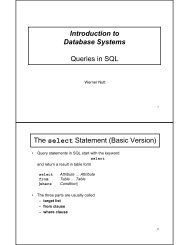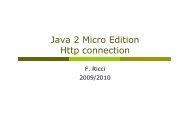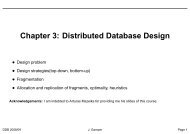Java 2 Micro Edition Socket, SMS and Bluetooth
Java 2 Micro Edition Socket, SMS and Bluetooth
Java 2 Micro Edition Socket, SMS and Bluetooth
Create successful ePaper yourself
Turn your PDF publications into a flip-book with our unique Google optimized e-Paper software.
<strong>Java</strong> 2 <strong>Micro</strong> <strong>Edition</strong><br />
<strong>Socket</strong>, <strong>SMS</strong> <strong>and</strong> <strong>Bluetooth</strong><br />
F. Ricci<br />
2008/2009
Content<br />
� Other Connection Types<br />
� Responding to Incoming Connections<br />
� <strong>Socket</strong> <strong>and</strong> Server <strong>Socket</strong><br />
� Security<br />
� Permissions<br />
� Security domains<br />
� Midlet signing<br />
� Wireless Messaging<br />
� Responding to incoming messages<br />
� <strong>Bluetooth</strong> <strong>and</strong> OBEX
Other Connection Types<br />
� MIDP specification requires only HTTP <strong>and</strong> HTTPS<br />
connections, but devices may also choose to implement<br />
access to serial ports through the generic connection<br />
framework<br />
� Additional connection types, their supporting connection<br />
interface <strong>and</strong> example connection string:<br />
Type<br />
<strong>Socket</strong><br />
Server socket<br />
TLS or SSL socket<br />
Serial port<br />
Interface<br />
<strong>Socket</strong>Connection<br />
Server<strong>Socket</strong>Connection<br />
SecureConnection<br />
CommConnection<br />
Example<br />
socket://localhost:79<br />
socket://:129<br />
ssl://localhost:79<br />
comm:com0;baudrate=19200
<strong>Socket</strong> <strong>and</strong> Server<strong>Socket</strong><br />
InputConnection<br />
openDataInputStream()<br />
openInputStream()<br />
ContentConnection<br />
getEncoding()<br />
getLength()<br />
getType()<br />
StreamConnection<br />
HttpConnection<br />
HttpsConnection<br />
Connection<br />
close()<br />
OutputConnection<br />
openDataOutputStream()<br />
openOutputStream()<br />
<strong>Socket</strong>Connection<br />
getLocalAddress()<br />
getLocalPort()<br />
getAddress()<br />
getPort()<br />
SecureConnection<br />
StreamConnectionNotifier<br />
acceptAndOpen()<br />
Server<strong>Socket</strong>Connection<br />
getLocalAddress()<br />
getLocalPort()<br />
the remote address<br />
to which the socket<br />
is bound
<strong>Socket</strong> <strong>and</strong> Server<strong>Socket</strong><br />
� In a socket connection: a socket is accessed using a<br />
generic connection string with an explicit host <strong>and</strong> port<br />
number<br />
� E.g.: socket://host.com:79<br />
� The MIDLet connects to a server’s socket<br />
� Server<strong>Socket</strong>Connection provides the ability to listen for<br />
incoming socket connections while a MIDlet is running<br />
� A server socket is accessed using a generic connection<br />
string with the host omitted<br />
� E.g.: socket://:79 defines an inbound server socket<br />
on port 79<br />
� The MIDLet is the server to whom other components will<br />
connect<br />
� The acceptAndOpen() method of Server<strong>Socket</strong> returns a<br />
<strong>Socket</strong>Connection instance (to whom called the server).
Responding to Incoming Connections (I)<br />
� MIDP allow MIDlets to be launched in response to<br />
incoming network connections (socket or even <strong>SMS</strong>)<br />
� The name of this technique is push<br />
� A MIDlet may register for push connection in two<br />
ways<br />
� At runtime calling static methods of PushRegistry<br />
(we do not show this – look at the API description<br />
<strong>and</strong> examples)<br />
� At installation time using special entry in the<br />
application descriptor (JAD)<br />
� Inside the MIDlet, catch the incoming connection<br />
using the acceptAndOpen() method of Server<strong>Socket</strong><br />
(previously open with Connector.open()).
Responding to Incoming Connections (II)<br />
� For example: a web server in MIDlet called<br />
PatchyMidlet<br />
� This MIDlet responds to incoming socket connections<br />
on port 82 (or whatever you like, e.g., 80)<br />
� If you want to register at runtime you have to write in<br />
your midlet some code like this<br />
PushRegistry.registerConnection(“socket://:82<br />
, PatchyMIDlet, “*”);<br />
� The first parameter indicates the listening socket, the<br />
second the MIDlet to run, <strong>and</strong> the third a filter on<br />
incoming IP address - the * indicates that all<br />
addresses are accepted<br />
� To register the connection at installation time, simply<br />
put the following line in the descriptor (JAD)<br />
MIDlet-Push-1: socket://:82, PatchyMidlet, *
PatchyMIDlet.java<br />
// import omitted<br />
public class PatchyMIDlet extends MIDlet implements Comm<strong>and</strong>Listener,<br />
Runnable {<br />
private Display mDisplay;<br />
private Form mForm;<br />
private Server<strong>Socket</strong>Connection mServer<strong>Socket</strong>Connection;<br />
private boolean mTrucking = true;<br />
public void startApp() {<br />
mDisplay = Display.getDisplay(this);<br />
}<br />
if (mForm == null) {<br />
mForm = new Form("PatchyMIDlet");<br />
mForm.addComm<strong>and</strong>(new Comm<strong>and</strong>("Exit", Comm<strong>and</strong>.EXIT, 0));<br />
mForm.setComm<strong>and</strong>Listener(this);<br />
}<br />
Thread t = new Thread(this);<br />
t.start();<br />
mDisplay.setCurrent(mForm);<br />
code
PatchyMIDlet.java<br />
public void pauseApp() {}<br />
public void destroyApp(boolean unconditional) { shutdown(); }<br />
private void log(String text) { log(null, text); }<br />
private void log(String label, String text) {<br />
StringItem si = new StringItem(label, text);<br />
si.setLayout(Item.LAYOUT_NEWLINE_AFTER);<br />
mForm.append(si);<br />
}<br />
private void shutdown() {<br />
mTrucking = false;<br />
try { mServer<strong>Socket</strong>Connection.close(); }<br />
catch (IOException ioe) {}<br />
}<br />
public void comm<strong>and</strong>Action(Comm<strong>and</strong> c, Displayable s) {<br />
if (c.getComm<strong>and</strong>Type() == Comm<strong>and</strong>.EXIT) {<br />
shutdown();<br />
notifyDestroyed();<br />
}<br />
}
PatchyMIDlet.java<br />
public void run() {<br />
try {<br />
mServer<strong>Socket</strong>Connection = (Server<strong>Socket</strong>Connection)<br />
Connector.open("socket://:82");<br />
log("Startup complete.");<br />
<strong>Socket</strong>Connection sc = null;<br />
while (mTrucking) {<br />
sc = (<strong>Socket</strong>Connection)<br />
mServer<strong>Socket</strong>Connection.acceptAndOpen();<br />
log("client: ", sc.getAddress());<br />
Reader in = new InputStreamReader(<br />
sc.openInputStream());<br />
String line;<br />
while ((line = readLine(in)) != null) ;<br />
// Ignoring the request, send a response.<br />
PrintStream out = new PrintStream(sc.openOutputStream());<br />
out.print("HTTP/1.1 200 OK\r\n\r\n");<br />
out.print(getMessage());<br />
out.close();<br />
in.close();<br />
sc.close();<br />
}<br />
}<br />
catch (Exception e) {log("exception: ", e.toString());}}
PatchyMIDlet.java<br />
private String readLine(Reader in) throws IOException {<br />
StringBuffer line = new StringBuffer();<br />
int i;<br />
while ((i = in.read()) != -1) {<br />
char c = (char)i;<br />
if (c == '\n') break;<br />
if (c == '\r') ;<br />
else line.append(c);<br />
}<br />
if (line.length() == 0) return null;<br />
return line.toString();<br />
}<br />
private java.util.R<strong>and</strong>om mR<strong>and</strong>om = new java.util.R<strong>and</strong>om();<br />
private String getMessage() {<br />
int i = Math.abs(mR<strong>and</strong>om.nextInt()) % 5;<br />
String s = null;<br />
switch (i) {<br />
case 0: s = "Above all the others we'll fly"; break;<br />
case 1: s = "There is no reason to hide"; break;<br />
case 2: s = "I dreamed about Ray Charles last night"; break;<br />
case 3: s = "Someone keeps moving my chair"; break;<br />
case 4: s = "Joseph's face was black as night"; break;<br />
default: break;<br />
}<br />
return s;}}
Responding to Incoming Connections (III)<br />
� The J2ME<br />
Wireless Toolkit<br />
allows you to<br />
register <strong>and</strong> test<br />
push connections<br />
� Click the<br />
Settings button<br />
<strong>and</strong> choose the<br />
Push Registry<br />
icon
Responding to Incoming Connections (IV)<br />
� To test the push notification, you’ll<br />
have to package the application <strong>and</strong><br />
then deploy it on the WTK via OTA<br />
� Does not work with NetBeans<br />
� Choose<br />
Project � Package � Create Package<br />
to package the project into a JAR<br />
� Then choose<br />
Project � Run via OTA<br />
� You’ll see emulator pop up showing its<br />
Application Management Software<br />
(AMS)<br />
� You’ll see other prompts during the<br />
installation, say yes to everything<br />
� The emulator is now running, listening<br />
for incoming connections, even though<br />
no MIDlets are running<br />
� Call it at http://localhost:82
Permissions <strong>and</strong> Security Domains<br />
� MIDP 2.0 includes a security framework that is<br />
designed to prevent MIDlets from running up your<br />
phone bill by making unauthorized network<br />
connections<br />
� There are Permissions <strong>and</strong> Security Domains<br />
� Permission have names corresponding to the API<br />
that they protect <strong>and</strong> MIDlet suites can indicate their<br />
need for certain kinds of permissions through<br />
attributes in the MIDlet suite descriptor<br />
� MIDlets must have permission to perform sensitive<br />
operations, such as connecting to the network<br />
� You can add these permission attributes to a project<br />
by clicking the Settings button in KToolbar.
� This<br />
permission<br />
s must be<br />
declared if<br />
you want<br />
to sign<br />
your<br />
MIDlet<br />
� Permission<br />
s are<br />
written in<br />
the .jad file
Security Policies<br />
� The Sun <strong>Java</strong>TM Wireless Toolkit for CLDC supports<br />
the security policies defined by both JSR 185 (<strong>Java</strong><br />
Technology for the Wireless Industry or JTWI) <strong>and</strong><br />
JSR 248 (Mobile Service Architecture or MSA)<br />
� When you run a MIDlet in the toolkit it runs in the<br />
unidentified_third_party security domain by<br />
default<br />
� To change this you must go to<br />
� Edit>Preferences <strong>and</strong> then “security”<br />
Set to<br />
maximum<br />
domain
Permissions for Network Connections<br />
� In the unidentified_third_party security<br />
domain, HTTP <strong>and</strong> HTTPS connection are allowed<br />
if the user grants permission<br />
� You can indicate the necessary <strong>and</strong> optional<br />
permission used by a MIDlet using the MIDlet-<br />
Permission <strong>and</strong> MIDlet-Permission-Opt<br />
description attributes – access them from<br />
“settings” (see previous slide)<br />
� It is not m<strong>and</strong>atory to indicate the necessary<br />
<strong>and</strong> optional permission but is a good practice<br />
(see next slides on signing midlets).
Protection Domains<br />
� The unidentified_third_party domain provides a high<br />
level of security for applications whose origins <strong>and</strong><br />
authenticity cannot be determined - the user is prompted<br />
frequently when the application attempts a sensitive<br />
operation<br />
� The identified_third_party domain is for MIDlets whose<br />
origins have been determined using cryptographic<br />
certificates - permissions are not granted automatically but<br />
the user will be prompted less<br />
� The manufacturer domain is intended for MIDlet suites<br />
whose credentials originate from the manufacturer’s root<br />
certificate (e.g. Nokia)<br />
� MIDlets in the minimum domain are denied all<br />
permissions<br />
� MIDlets in the maximum domain are granted all<br />
permissions.
Protection Domains <strong>and</strong> OTA<br />
� Your packaged MIDlet suite is installed directly into the<br />
emulator - it is placed in a protection domain at<br />
installation time<br />
� The emulator uses public key cryptography to determine<br />
the protection domain of installed MIDlet suites<br />
� If the MIDlet suite is not signed, it is placed in the<br />
unidentified_third_party domain<br />
� If the MIDlet is signed, it is placed in whatever protection<br />
domain is associated with the root certificate of the signing<br />
key’s certificate chain<br />
� If for instance a company sign a midlet using a key pairs<br />
from Verisign, then the midlet is put in the protection<br />
domain associated with the root certificate of Verisign, <strong>and</strong><br />
hence (probably) identified_third_party domain.
Signing a MIDlet<br />
� To sign a MIDlet suite, you must declare the<br />
required permissions <strong>and</strong> then package it<br />
(do not package it after signing)<br />
� Then choose Project > Sign from the KToolbar<br />
menu<br />
� select the key you want to use in the Alias List<br />
<strong>and</strong> click on the Sign MIDlet Suite... button
Creating a new key pair<br />
� To create a new key pair Project > Sign from<br />
the KToolbar menu<br />
� After you click on Create, the toolkit prompts<br />
you to choose a protection domain where the<br />
MIDlet signed with that will be put.
Installing via OTA a signed MIDlet<br />
� When you install a signed MIDlet something is<br />
different<br />
� Then everything runs as before (because myself<br />
as authority is considered as not very reliable <strong>and</strong><br />
the midlet is put in the same domain as before –<br />
unidentified_third_party).
Playing with Protection Domains<br />
� Run the PatchyMIDlet (not via OTA) in the WTK<br />
� Change the protection domains: using<br />
Edit>Preferences <strong>and</strong> the Security<br />
� In the minimum protection domain it does not<br />
work!
Wireless Messaging API - WMA<br />
� WMA 1.1. is an optional API that enables MIDP application<br />
to leverage the utility of <strong>SMS</strong><br />
� The WMA 2.0 adds support for MMS (Multimedia) messages<br />
� Messages can now be sent <strong>and</strong> received between phones<br />
without:<br />
� Having internet access (additional cost service)<br />
� Going through an intermediary server (potentially from<br />
the carrier at additional cost)<br />
� Being restricted in terms of routing by the carrier’s<br />
network<br />
� The possible applications are unlimited: chat-type<br />
applications, interactive gaming, event reminders, e-mail<br />
notification, mobile access to corporate resources,<br />
informational services, …
WMA <strong>and</strong> <strong>SMS</strong><br />
� <strong>SMS</strong> can be used with the push registry to launch<br />
MIDlets on your cell phone<br />
� Using WMA the message can now be larger in size than a<br />
single message <strong>and</strong> the content is no longer restricted to<br />
simple text message<br />
� Under the hood, the WMA API will do the following<br />
� Encode binary message <strong>and</strong> transmit it through <strong>SMS</strong><br />
� Cut up a long message into segments, <strong>and</strong> send it via<br />
multiple (up to three) <strong>SMS</strong> messages<br />
� Two current <strong>and</strong> finalized JSRs are relevant to WMA<br />
� The JSR 120 (WMA 1.1) all devices that support WMA<br />
have WMA 1.1 implementation<br />
� The JSR 205 (WMA 2.0 support for multimedia<br />
messaging - MMS) these messages are perfect for<br />
carrying images, sound, video, or multimedia<br />
presentations.
WMA API<br />
� WMA is built on top of CLDC <strong>and</strong> requires only the Generic<br />
Connection Framework<br />
� Like <strong>Socket</strong>Connection, you get a MessageConnection by<br />
passing in an address to the open() method<br />
� Unlike other connections, you cannot open in/out stream<br />
from it - MessageConnections are only used to send <strong>and</strong><br />
receive messages<br />
javax.microedition.io CLDC 1.0<br />
java.wireless.messaging<br />
JSR-120<br />
WMA 1.1<br />
Message MessageConnection<br />
TextMessage BinaryMessage<br />
newMessage()<br />
Connection<br />
JSR-205<br />
WMA 2.0<br />
MultipartMessage
Creating New Messages<br />
� First open a MessageConnection like:<br />
MessageConnection msgConn = (MessageConnection)<br />
Connector.open(“sms://5550001:1234”);<br />
� This will create a client mode connection to send<br />
messages<br />
� You can create a server mode connection - send <strong>and</strong><br />
receive <strong>SMS</strong> -calling<br />
MessageConnection msgConn = (MessageConnection)<br />
Connector.open(“sms://:1234”);<br />
� If you want to send messages you first need to create an<br />
empty one calling the factory method (of<br />
MessageConnection)<br />
Message newMessage(String messageType);<br />
Message newMessage(String messageType, String<br />
address);<br />
� The second method is used when the message is created<br />
from a server mode connection – determines the address<br />
of the receiver.
Sending Text <strong>SMS</strong> Messages<br />
� There are three types of messages:<br />
� MessageConnection.TEXT_MESSAGE<br />
� MessageConnection.BINARY_MESSAGE<br />
� MessageConnection.MULTIPART_MESSAGE (only for WMA 2.0 –<br />
to support multimedia)<br />
� Create an empty message specifying<br />
MessageConnection.TEXT_MESSAGE as its type<br />
� Next set the payload with the text string that you want to<br />
send<br />
� Finally use the send() method for sending<br />
MessageConnection conn = (MessageConnection)<br />
Connector.open(“sms://5550001:1234”);<br />
TextMessage txtmessage = (TextMessage)conn.newMessage(<br />
MessageConnection.TEXT_MESSAGE);<br />
txtmessage.setPayloadText(msgString);<br />
conn.send(textmessage);
Sending Binary <strong>SMS</strong> Messages<br />
� First create an empty message using the<br />
newMessage() method of the opened<br />
MessageConnection specifying<br />
MessageConnection.BINARY_MESSAGE for its type<br />
� Get binary data into a byte array<br />
� Set the payload of the BinaryMessage using<br />
Public void setPayloadData(byte[] data);<br />
� Then you can send the message using this<br />
MessageConnection method<br />
void send (Message msg);<br />
� As with any network operations, you should call<br />
send() on a separate non-GUI thread to avoid<br />
hanging the GUI<br />
� When you are using server mode you must set the<br />
recipient address (setAddress()).
<strong>SMS</strong> size limitations<br />
� Binary messages are limited to 133 bytes per <strong>SMS</strong><br />
� Longer messages will be separated by WMA into<br />
segments<br />
� Text messages are limited to 66 characters<br />
� Longer messages will be separated by WMA into<br />
segments<br />
� int<br />
MessageConnection.numberOfSegments(Message<br />
msg) returns the number of segments required in the<br />
underlying protocol<br />
� But it is better not to use more than 3 segments,<br />
i.e., 189 characters (text) or 381 bytes (binary),<br />
because implementations MUST support only 3<br />
segments.
Receiving <strong>SMS</strong> Messages<br />
� To receive messages using a<br />
MessageConnection, you have two choices:<br />
� 1) Use a blocking receive() method<br />
� 2) Implement a listener callback to be<br />
notified when a message arrives<br />
� When using the blocking receive() method, you<br />
typically will be managing your own threads<br />
� Using a listener allows you to code the logic in a<br />
callback method, without creating <strong>and</strong> managing<br />
additional threads.
Calling the Blocking receive() Method<br />
� The blocking receive() method is on the<br />
MessageConnection interface<br />
� This method will block the incoming call until<br />
an incoming message is available or until the<br />
connection is closed<br />
� Since receive() is a blocking call, it should<br />
always be called on its own thread<br />
� A common approach is to create a “receiver<br />
thread” to receive messages in an application<br />
� Closing a MessageConnection is a way to release<br />
a receiver thread that may be blocked waiting for<br />
incoming messages.
Message receive code example<br />
conn = (MessageConnection)<br />
Connector.open(“sms://:1234”); //server mode<br />
msg = conn.receive(); // Blocking here<br />
mSenderAddress = msg.getAddress();<br />
if (msg instanceof TextMessage) {<br />
String msgReceived =<br />
((TextMessage)msg).getPayloadText();<br />
// do something with the message here<br />
} else if (msg instanceof BinaryMessage) {<br />
For Binary<br />
byte [] msgReceived =<br />
Messages<br />
((BinaryMessage)msg).getPayloadData();<br />
// do something with the binary message here<br />
}<br />
For Text<br />
Messages
A Nonblocking Approach to Receiving <strong>SMS</strong> Messages<br />
� MessageConnection supports a nonblocking, event<br />
listener-based way for receiving <strong>SMS</strong> messages - to use<br />
this, you will need the following:<br />
� Register a MessageListener with the<br />
MessageConnection -using setMessageListener() -<br />
the object you registered must implement the<br />
MessageListener interface (e.g. the midlet itself)<br />
� H<strong>and</strong>le the callback on the<br />
notifyIncomingMessage(MessageConnection conn)<br />
method of the MessageListener interface<br />
� The callback is performed by WMA on a system thread, <strong>and</strong><br />
the notifyIncomingMessage() method must return as<br />
soon as possible<br />
� This mean that any work should performed by another<br />
thread.<br />
� A detailed example is provided in the API description<br />
wma_2.0-fr_wma_ext-102-fr-spec.pdf
Examining Message Headers<br />
� In addition to the binary or text payload, other interesting<br />
information appears in the message header<br />
� You can access the address information using the following<br />
methods on the Message interface<br />
� public String getAddress();<br />
� public void setAddress();<br />
� The Message interface is the super interface of both<br />
TextMessage <strong>and</strong> BinaryMessage<br />
� The getAddress() returns:<br />
� the recipient’s address if it is an outgoing message, or<br />
� the sender address if it is an incoming message<br />
� in fact, incoming messages can be reused for replies by<br />
just setting a new payload<br />
� Another method on the Message interface provides access<br />
to the timestamp on the message:<br />
� public Date getTimestamp()
Working With <strong>SMS</strong> APIs - <strong>SMS</strong>Midlet<br />
� The <strong>SMS</strong>Midlet example<br />
can be used to receive or send <strong>SMS</strong><br />
messages<br />
� If you send a message with the word<br />
“red” or “blue”, an image with a red or<br />
blue background will be displayed by<br />
the receiving MIDlet<br />
� You can enter the address that you<br />
want to send <strong>SMS</strong> messages to into<br />
the<br />
“Connect to:” text field<br />
� Using the menu you can then send<br />
either a “red” or “blue” <strong>SMS</strong> message<br />
to the recipient.
<strong>SMS</strong>Midlet<br />
private void startReceive() {<br />
if (mReceiver != null)<br />
return;<br />
// start receive thread<br />
mReceiver = new Thread(this);<br />
mReceiver.start();<br />
}<br />
private boolean mEndNow = false;<br />
private MessageConnection conn = null;<br />
public void run() {<br />
Message msg = null;<br />
String msgReceived = null;<br />
conn = null;<br />
mEndNow = false;<br />
/** Check for sms connection. */<br />
try {<br />
conn = (MessageConnection) Connector.open("sms://:" + mPort);<br />
msg = conn.receive();<br />
while ((msg != null) && (!mEndNow)) {<br />
}<br />
if (msg instanceof TextMessage) {<br />
}<br />
msgReceived = ((TextMessage)msg).getPayloadText();<br />
if (msgReceived.equals("red")) {<br />
Display.getDisplay(this).callSerially(new SetRed());<br />
} else if (msgReceived.equals("blue")) {<br />
Display.getDisplay(this).callSerially(new SetBlue());<br />
}<br />
msg = conn.receive();<br />
}<br />
} catch (IOException e) {<br />
// normal exit when connection is closed<br />
}<br />
<strong>SMS</strong>MIDlet uses a separate<br />
receive thread. The<br />
startReceive() method<br />
contains the code that<br />
starts the receive thread.<br />
The run() method contains<br />
the logic of the receive<br />
thread. The blocking<br />
receive() call is used in<br />
this case.<br />
<strong>SMS</strong>MIDlet.java<br />
Sender.java
Testing <strong>SMS</strong>MIDlet with WTK 2.x WMA Console<br />
� You can test <strong>SMS</strong>MIDlet using a utility called the WMA<br />
console in WTK 2.x. To access the WMA console, select<br />
File � Utilities from KToolbar.<br />
Then click the Open Console button in the WMA box.<br />
� To test Start <strong>SMS</strong>MIDlet, first start an instance of the<br />
emulator. The caption contains the phone number assigned<br />
to the emulator (+55 50 000 by default)<br />
� Start the WMA console, select the address of the emulator<br />
+55 500 000, enter 1234 into the Port box, <strong>and</strong> then enter<br />
red for the message <strong>and</strong> click the Send button. Note that<br />
the <strong>SMS</strong>MIDlet instance now displays an image with a red<br />
background<br />
� Instead to start the WMA console you can also start two<br />
emulator instances of <strong>SMS</strong>MIDlet <strong>and</strong> send <strong>SMS</strong> messages<br />
between them.
<strong>SMS</strong> for launching applications<br />
� As we shown for the socket connection<br />
� A midlet can be started when an <strong>SMS</strong> is received<br />
� It must be deployed via OTA
Receiving CBS Messages<br />
� Cell Broadcast Service, or CBS is a carrier version of <strong>SMS</strong><br />
- it enables a cell phone operator to broadcast messages to<br />
a group of cell phone users<br />
� A WMA application can only receive CBS messages, so the<br />
MessageConnection for CBS can only be opened in the<br />
server (receiver) mode<br />
� conn = (MessageConnection)<br />
Connector.open(“cbs://:12345”);<br />
� msg = conn.receive(); // Blocking for message<br />
� The digits 12345 serves as a message identifier, they may<br />
represent different information channels that you can<br />
subscribe to<br />
� In Italy only the channel “50” is available. On this<br />
channel you should receive information about cell area<br />
every 10 seconds.
See also…<br />
� HTTP MIDlet examples<br />
http://www.java2s.com/Code/<strong>Java</strong>/J2ME/HttpMIDlet.htm<br />
� MIDP Network Programming using HTTP <strong>and</strong> the<br />
Connection Framework<br />
http://developers.sun.com/techtopics/mobility/midp/article<br />
s/network/index.html<br />
� The Wireless Messaging API 2.0<br />
http://developers.sun.com/techtopics/mobility/midp/article<br />
s/wma2/<br />
� WMA 2.0 Specification<br />
http://jcp.org/about<strong>Java</strong>/communityprocess/final/jsr120/in<br />
dex2.html
<strong>Bluetooth</strong><br />
� <strong>Bluetooth</strong> is supported by an optional package of the<br />
MIDP profile - JSR-82<br />
� A network of devices connected via <strong>Bluetooth</strong> is called<br />
a PAN (Personal Area Network)<br />
� A single <strong>Bluetooth</strong> device can offer multiple services<br />
� Devices can be either client or server (or both)<br />
� Devices are the discoverable entities <strong>and</strong> are<br />
discovered by making an enquire<br />
� Each service is uniquely identified by a UUID<br />
(Universal Unique Identifier) a 128 bits number –<br />
8967A780CC8876536372542AC543F11 in hex format<br />
(part is defined by the device physical address, part<br />
specifies the service <strong>and</strong> part is r<strong>and</strong>om).
<strong>Bluetooth</strong> Example<br />
� In these slides we show a simple example of<br />
<strong>Bluetooth</strong> usage: a MIDlet sending a file to<br />
another <strong>Bluetooth</strong> device (Phone, PC, etc…)<br />
� The basic steps required for sending a file to a<br />
paired <strong>Bluetooth</strong> device<br />
� Start the devices' discovery process<br />
� Query the devices found in the discovery<br />
process for supported services<br />
� Initiate <strong>and</strong> process an OBEX data exchange<br />
using the supported service URL.
Screenshots<br />
RICCI-VAIO PC alert
Main classes/interfaces<br />
� LocalDevice : represents the local device<br />
� DiscoveryAgent : to discover other devices <strong>and</strong><br />
services<br />
� DiscoveryListener : 4 methods of this class provide<br />
the callbacks that are executed when devices or<br />
services are found<br />
� ServiceRecord : <strong>and</strong> entry in the Service Discovery<br />
Database (SDDB) maintained by the <strong>Bluetooth</strong><br />
manager in each device – provides various info, such<br />
as the URL of the service<br />
� ClientSession: in the OBEX api allows to send client<br />
requests (returned by the Connector.open(URL) call)<br />
� Operation : an OBEX operation returned by a PUT or<br />
GET OBEX request.
Search for devices<br />
� A DiscoveryAgent is initialized <strong>and</strong> asked to search for<br />
devices (GIAC = General Inquire Access Code)<br />
// get the local discovery agent agent =<br />
LocalDevice.getLocalDevice().getDiscoveryAgent();<br />
// start the inquiry for general unlimited inquiry<br />
agent.startInquiry(DiscoveryAgent.GIAC, this);<br />
� The DiscoveryAgent will call various callback methods<br />
implemented by a DiscoveryListener interface (here the<br />
midlet – the 'this' in the call above)<br />
� deviceDiscovered(RemoteDevice btDevice,<br />
DeviceClass cod): every time a new device is<br />
discovered<br />
� inquiryCompleted(int discType): when the search<br />
terminates (discType = INQUIRE_COMPLETED, INQUIRE<br />
TERMINATED, INQUIRE_ERROR)
Device discovered<br />
public void deviceDiscovered(RemoteDevice btDevice,<br />
DeviceClass cod) {<br />
try {<br />
// add the devices using the friendly names<br />
listofDevices.append(btDevice.getFriendlyName(false),<br />
null);<br />
// add to the devices hashtable<br />
devices.put(new Long(listofDevices.size()), btDevice);<br />
} catch(Exception ex) { h<strong>and</strong>leError(ex); }<br />
}<br />
public void inquiryCompleted(int discType) {<br />
// once the inquiry is completed, show the list of devices<br />
to the user<br />
if(listofDevices.size() == 0) {<br />
display.setCurrent(nothing, noteBox);<br />
} else {<br />
display.setCurrent(listofDevices);<br />
}<br />
}
Search for services<br />
agent.searchServices(<br />
null, // service's attributes required<br />
new UUID[] {new UUID(0x1105L)}, // we want the OBEX<br />
// PUSH Profile<br />
device,<br />
this); //the discovery listener<br />
� Uses the same discovery agent used to search for devices<br />
� The DiscoveryListener must also implement the following<br />
callbacks<br />
� servicesDiscovered(int transID, ServiceRecord[]<br />
servRecord): called each time some services are<br />
discovered - transID is the integer returned by the<br />
agent.searchServices() call<br />
� serviceSearchCompleted(int transID, int<br />
respCode): called when the service process has<br />
completed.
Obtaining the URL of the service<br />
� In this example, each time a service is discovered it is<br />
inserted in the array servRecord[i]<br />
� Then the connection URL for that particular service on the<br />
respective device is obtained:<br />
String connURL =<br />
servRecord[i].getConnectionURL(ServiceRecord.NOAUTHENTIC<br />
ATE_NOENCRYPT, false);<br />
� The first parameter describe the security required <strong>and</strong> the<br />
second if this is master service (true)<br />
� This connection URL will be used to make the OBEX<br />
connection for putting our data across, <strong>and</strong> consists of the<br />
<strong>Bluetooth</strong> hardware address of the device, among other<br />
things<br />
� Connector.open("btgoep://0016FE9244DB<br />
…;key1=val1;key2=val2")
OBEX requests<br />
� OBEX (Object Exchange) is a protocol designed to<br />
exchange data such as contact, vCalendar, vCard<br />
� OBEX can be used with <strong>Bluetooth</strong> <strong>and</strong> IrDA<br />
� OBEX is a request response protocol (as HTTP)<br />
� A request can contain headers <strong>and</strong> a body<br />
� Headers can also be user-defined<br />
� There are different types of requests: CONNECT,<br />
PUT, GET, DELETE, SETPATH, DISCONNET
Sending Data<br />
// open a client session<br />
ClientSession clientSession =<br />
(ClientSession) Connector.open(connURL);<br />
// connect using no headers<br />
HeaderSet rHeaders =<br />
clientSession.connect(null);<br />
if(rHeaders.getResponseCode() !=<br />
ResponseCodes.OBEX_HTTP_OK) {<br />
// the connection could not be established<br />
h<strong>and</strong>leError(<br />
new Exception("Remote client returned<br />
invalid response code: " +<br />
rHeaders.getResponseCode()));<br />
return;<br />
}
Sending Data (II)<br />
// if we are here, then response code was ok<br />
// create a new set of headers<br />
HeaderSet headers = clientSession.createHeaderSet();<br />
headers.setHeader(<br />
HeaderSet.LENGTH,<br />
new Long(noteBox.getString().length()));<br />
headers.setHeader(HeaderSet.NAME, "myNote.txt");<br />
headers.setHeader(HeaderSet.TYPE, "text/plain");<br />
// create an operation using the headers we have just<br />
created<br />
Operation op = clientSession.put(headers);<br />
// on this operation, create the output stream<br />
OutputStream out = op.openOutputStream();<br />
// <strong>and</strong> send the note<br />
out.write(noteBox.getString().getBytes());
References<br />
� Technical article with this example<br />
� http://blogs.sun.com/mobility_techtips/entry/d<br />
iscovering_devices_<strong>and</strong>_sending_files<br />
� Specifications of JSR 82<br />
� http://jcp.org/en/jsr/detail?id=82<br />
� Chapter 12 in your book (Beginning J2ME).



